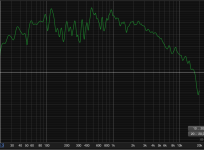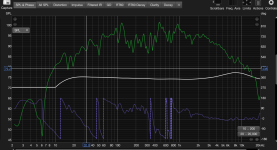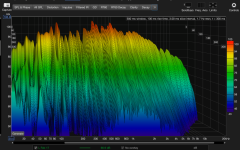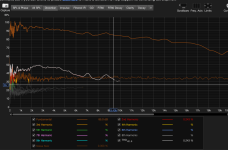Happy Saturday, all.
I'm at the assembly portion of my DIY 2-Way build - and am currently utilizing a Dayton Audio DSP-408 as an active crossover. This will change - but is super convenient for now.
The system is a 22" Oris Circular Horn w/ Celestion AxI2050 Compression driver, and midbass / bass is handled by an 18" Acoustic Elegance TD18H+ Apollo driver.
I have not finished the cabinet, and it is just bare MDF on the inside - even the external curved baffle isn't installed yet to the facia. It's not even glued together at this point - just clamped together for some driver measurements. The cabinet was custom cut as a mid bass module by GSGAudio specifically tuned for this driver, it's a 5.75cf cabinet with a slot port tuned to 27hz, which is also where I have the high pass filter set on the driver.
That said - I'm hoping someone can help me make sense of the various REW screens - all measurements taken at MLP, Audessy off.
Thanks so much.
Kind of wondering where I go from here - still left to do is proper damping of the cabinet, proper crossover build, etc.
I'm very interested in the waterfall and distortion measurements...
AND if I'm even doing the testing correctly. Thanks so much!
And as before - I'm pretty new to this - but enjoying the journey so far and definitely open to constructive criticism and suggestions / ideas.
I'm at the assembly portion of my DIY 2-Way build - and am currently utilizing a Dayton Audio DSP-408 as an active crossover. This will change - but is super convenient for now.
The system is a 22" Oris Circular Horn w/ Celestion AxI2050 Compression driver, and midbass / bass is handled by an 18" Acoustic Elegance TD18H+ Apollo driver.
I have not finished the cabinet, and it is just bare MDF on the inside - even the external curved baffle isn't installed yet to the facia. It's not even glued together at this point - just clamped together for some driver measurements. The cabinet was custom cut as a mid bass module by GSGAudio specifically tuned for this driver, it's a 5.75cf cabinet with a slot port tuned to 27hz, which is also where I have the high pass filter set on the driver.
That said - I'm hoping someone can help me make sense of the various REW screens - all measurements taken at MLP, Audessy off.
Thanks so much.
Kind of wondering where I go from here - still left to do is proper damping of the cabinet, proper crossover build, etc.
I'm very interested in the waterfall and distortion measurements...
AND if I'm even doing the testing correctly. Thanks so much!
And as before - I'm pretty new to this - but enjoying the journey so far and definitely open to constructive criticism and suggestions / ideas.
Attachments
Some descriptions of your images/measurements would help (what exactly you are measuring [whole speaker or single driver], where was microphone vs. speaker, where were they in the world/room/etc.). I assume your MLP abbreviation is Main Listening Position and it was used for all measurements, but I'm assuming. Acronyms often confuse things, so it's helpful to spell things out precisely at least once. It matters.
Are we only viewing woofer response at the moment or is your horn just rolling off the highs? It'll be harder to judge some of this if your enclosure isn't really done yet. Any leaks/rattles could corrupt measurements.
It also looks like you're using a long window/gating. That makes things harder in a home environment (if that's where the measurements took place), since you'll have reflections from floor/ceiling/walls contaminating the measurement. In the bass range, this is often handled by taking nearfield measurements. At higher frequencies windowing the measurement is typically used to eliminate reflections (quasi-anechoic measurement).
Nearfield is also handy for distortion measurements in the bass range, since it makes it easier to get above the noise floor. You're probably in it given what I can see on your graphs. If your actual distortion is below the noise floor, you can't measure it accurately. Many microphones top out around 120 dB, so you have to keep that in mind also.
Taking measurements at the listening position (often referred to as in-room response) is typically done later in the development/voicing stage and is inherently a more limited type of measurement. Waterfall and distortion aren't normally done this way (unless you are chasing room-specific issues).
Are we only viewing woofer response at the moment or is your horn just rolling off the highs? It'll be harder to judge some of this if your enclosure isn't really done yet. Any leaks/rattles could corrupt measurements.
It also looks like you're using a long window/gating. That makes things harder in a home environment (if that's where the measurements took place), since you'll have reflections from floor/ceiling/walls contaminating the measurement. In the bass range, this is often handled by taking nearfield measurements. At higher frequencies windowing the measurement is typically used to eliminate reflections (quasi-anechoic measurement).
Nearfield is also handy for distortion measurements in the bass range, since it makes it easier to get above the noise floor. You're probably in it given what I can see on your graphs. If your actual distortion is below the noise floor, you can't measure it accurately. Many microphones top out around 120 dB, so you have to keep that in mind also.
Taking measurements at the listening position (often referred to as in-room response) is typically done later in the development/voicing stage and is inherently a more limited type of measurement. Waterfall and distortion aren't normally done this way (unless you are chasing room-specific issues).
Last edited:
Thanks... and here's some clarification to your points:
The room size is 22x16x10 (roughly).
It's a front-port MartySub 2.1 MBM enclosure (roughly), and the UMIK 1 was positioned at the Main listening Position. I positioned it originally at 1M, and wasn't sure which way was best.
The horn and driver plays down to about 340hz - but in the posted examples I was fiddling around and used the following:
On the Horn / Compression driver: HP Filter: LR 24db slope @ 366hz ; LP Filter: LR 12db slope @ 20K
On the Woofer: HP Filter: Bessel 12db slope @ 25hz ; LP Filter: Bessel 24db slope @ 364hz
Are you suggesting I redo the measurements and place the microphone, say, 12" from the phase plug or?
Thanks again
The room size is 22x16x10 (roughly).
It's a front-port MartySub 2.1 MBM enclosure (roughly), and the UMIK 1 was positioned at the Main listening Position. I positioned it originally at 1M, and wasn't sure which way was best.
The horn and driver plays down to about 340hz - but in the posted examples I was fiddling around and used the following:
On the Horn / Compression driver: HP Filter: LR 24db slope @ 366hz ; LP Filter: LR 12db slope @ 20K
On the Woofer: HP Filter: Bessel 12db slope @ 25hz ; LP Filter: Bessel 24db slope @ 364hz
Are you suggesting I redo the measurements and place the microphone, say, 12" from the phase plug or?
Thanks again
A lot of it comes down to what you are trying to accomplish with your measurements. If you're just following a known design, some of it is less important.
For crossover work, initial quasi-anechoic measurements at 1 meter (or the minimum distance required for proper integration) are pretty typical. Stereophile uses 50 inches for theirs. This is a pretty good overview of the process they use and why. It gives a good overview of measurements in general and is worth a read even if you don't like some of their techniques or review methods:
https://www.stereophile.com/features/103/index.html
A nearfield measurement is typically done at around 1/4 inch from the cone. It has to be very close to be accurate. There's a formula for that to tell you the required distance and the highest frequency that's still accurate, but I can't find it at the moment.
Are you trying to incorporate equalization with your DSP/crossover or do you intend to handle EQ in Audyssey? I'm not sure if I should be commenting on the overall response or not.
For crossover work, initial quasi-anechoic measurements at 1 meter (or the minimum distance required for proper integration) are pretty typical. Stereophile uses 50 inches for theirs. This is a pretty good overview of the process they use and why. It gives a good overview of measurements in general and is worth a read even if you don't like some of their techniques or review methods:
https://www.stereophile.com/features/103/index.html
A nearfield measurement is typically done at around 1/4 inch from the cone. It has to be very close to be accurate. There's a formula for that to tell you the required distance and the highest frequency that's still accurate, but I can't find it at the moment.
Are you trying to incorporate equalization with your DSP/crossover or do you intend to handle EQ in Audyssey? I'm not sure if I should be commenting on the overall response or not.
Thanks - that’s very helpful and I appreciate the link. I will review.
Definitely not a known build- I’m really trying to create something probably out of an unusual combination- normally horns have horn loaded bass units.
I have a touch of eq boasting some of what I assume to be room modes at the moment - the huge nulls…
I know I’m supposed to pull down others … so probably not the correct method.
The compression driver falls off pretty steeply after 10k… I may supplement that or switch to a different driver if I can’t get that fixed.
And yes, I’d love your comments on the overall frequency sweep…
I plan on doing a mixture of crossover plus Audessy - I’d like it to be respectable on its own- something at least as good as a typical $5k store bought speaker- and then I can tweak for my room with Audessy.
Definitely not a known build- I’m really trying to create something probably out of an unusual combination- normally horns have horn loaded bass units.
I have a touch of eq boasting some of what I assume to be room modes at the moment - the huge nulls…
I know I’m supposed to pull down others … so probably not the correct method.
The compression driver falls off pretty steeply after 10k… I may supplement that or switch to a different driver if I can’t get that fixed.
And yes, I’d love your comments on the overall frequency sweep…
I plan on doing a mixture of crossover plus Audessy - I’d like it to be respectable on its own- something at least as good as a typical $5k store bought speaker- and then I can tweak for my room with Audessy.
Are you using a calibrated mic, e.g/Daytona UMM6 USB which is calibrated and comes with a calibration file for REW?
Roll-off in the top 1-2 octaves of compression driver/horn combinations is pretty common. Or stated another way, midrange prominence is common. Either way you look at it, the fix is typically the same: decreasing the drive at midrange frequencies. Your overall response shape looks like it's dominated by that trend above approximately 500 Hz. In a quasi-anechoic measurement, you want the whole range covered by your horn to be basically flat or to have a slight downward trend with increasing frequency (like about 2 dB, though the exact amount is subjective). Above 12 kHz is sometimes down more than optimal in horn systems, but doesn't have a big impact to many listeners, so that can often be squinted past.
In-room response normally has more downward trend with increasing frequency for several reasons, but yours still seems excessive. It likely sounds very live/dynamic at the moment. Some people like that kind of presentation, but it looks exaggerated from here.
If your enclosure isn't going to wind up closer to the front wall, your bass response looks rather lean also. You have good extension, but it's shelved down. If you haven't optimized the speaker and listener locations, that could be driving some of what I'm seeing there. Or maybe it's related to the baffle just being clamped on at the moment.
Filling in deep nulls with EQ can lead to problems if taken to extremes, since they're sometimes nearly impossible to bring all the way up. You can pour a lot of power into a driver trying to do what's not really feasible. 6 dB of boost is a commonly stated limit for this. Optimizing location in the room is a good idea before trying to fix bass response with EQ, though imaging/staging concerns also come into play in speaker placement and often have contradictory needs.
Your dip in the 150-400 Hz range is probably due to floor bounce (reflected energy cancelling some of the speaker output due to the path length difference between direct and reflected energy). That can sometimes be improved with changes in speaker height, but yours doesn't look bad at the moment, so may be as good as it gets. Crossover effects could be in there as well though. Have you done any time alignment/delay in the DSP? Or measured the drivers independently to see if that goes away when both drivers aren't playing simultaneously? I don't know what the physical setup looks like, so this may be less likely barring an error in DSP time delay, since the wavelengths are pretty long.
In-room response normally has more downward trend with increasing frequency for several reasons, but yours still seems excessive. It likely sounds very live/dynamic at the moment. Some people like that kind of presentation, but it looks exaggerated from here.
If your enclosure isn't going to wind up closer to the front wall, your bass response looks rather lean also. You have good extension, but it's shelved down. If you haven't optimized the speaker and listener locations, that could be driving some of what I'm seeing there. Or maybe it's related to the baffle just being clamped on at the moment.
Filling in deep nulls with EQ can lead to problems if taken to extremes, since they're sometimes nearly impossible to bring all the way up. You can pour a lot of power into a driver trying to do what's not really feasible. 6 dB of boost is a commonly stated limit for this. Optimizing location in the room is a good idea before trying to fix bass response with EQ, though imaging/staging concerns also come into play in speaker placement and often have contradictory needs.
Your dip in the 150-400 Hz range is probably due to floor bounce (reflected energy cancelling some of the speaker output due to the path length difference between direct and reflected energy). That can sometimes be improved with changes in speaker height, but yours doesn't look bad at the moment, so may be as good as it gets. Crossover effects could be in there as well though. Have you done any time alignment/delay in the DSP? Or measured the drivers independently to see if that goes away when both drivers aren't playing simultaneously? I don't know what the physical setup looks like, so this may be less likely barring an error in DSP time delay, since the wavelengths are pretty long.
Last edited:
Seriously much thanks for your explanation of all the above… incredibly helpful.
I’m going to make some physical adjustments and finish the cabinet including material and padding back wall etc and then take everything you’ve said in consideration including raising the bass up- I had planned on doing that anyway…
This is a great start to helping me understand though. I’ll reach out when it’s at the point of putting everything together for real.
Thank you again
I’m going to make some physical adjustments and finish the cabinet including material and padding back wall etc and then take everything you’ve said in consideration including raising the bass up- I had planned on doing that anyway…
This is a great start to helping me understand though. I’ll reach out when it’s at the point of putting everything together for real.
Thank you again
- Home
- Loudspeakers
- Multi-Way
- Measurements! Please comment and Advise...



